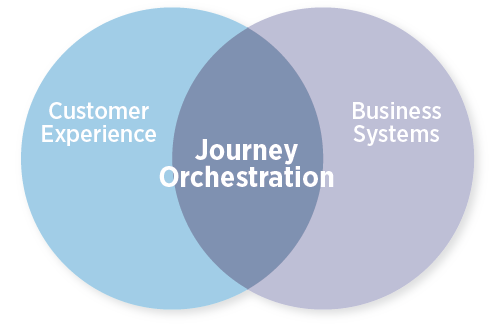
Two-thirds of customer journey mapping initiatives fail to drive action, as we revealed in our book How Hard Is It to Be Your Customer? Using Journey Mapping to Drive Customer-Focused Change.
That’s not really surprising, is it? It’s easier to reveal where customers are having problems than it is to do something about it. Taking effective action requires getting your silos aligned to improve the customer experience. A new class of software can help.
Journey orchestration software not only determines when and where customers are falling through the cracks between your silos, it designs cost-effective interventions to save them.
This new category builds on the foundation laid by journey analytics platforms, which take data from your siloed systems – CRM, ERP, financial systems, website, app, etc. – to show a single view of your customers and where they fall off.
Let’s examine a typical onboarding journey, where your customer takes the following steps:
At this point, onboarding has ended – your customer has created an account, provided the information you need to do business together, and has successfully ordered multiple times. Sounds easy, doesn’t it?
But as we all know, most customers don’t make it that far without encountering problems. By integrating data from your website, and financial, onboarding, and ordering systems with your CRM, a journey analytics platform can display the journey and how many customers exit at each step.
That’s critical information…but it’s not enough.
We know from journey mapping that just discovering where in the journey customers have problems doesn’t solve those problems. Driving change to improve the customer experience requires developing the ability to react appropriately when and where customers have problems. That’s where we move from analytics to orchestration. With journey orchestration software, you can assign actions (and reactions) based on the journey.
Let’s go back to that typical onboarding journey. Your journey mapping initiative revealed that many of your potential customers mistakenly equated creating a login with creating a payment account, and as a result, failed to complete a purchase. Journey orchestration software allows you to generate targeted, rule-based interventions to prevent that drop-off. If your customer creates a login, but not a payment account (which typically requires more information), journey orchestration software can:
Imagine the possibilities this opens up – and the opportunities. Not only could you send texts to your customers, or various types of emails, the system even allows you to A|B test, so you can try different versions of those communications to see which works best.
I’m so jazzed about this concept that we scanned the marketplace to find the best provider and decided to partner with Usermind to bring journey orchestration to our clients.
Most players in this space focus on pre-sales journeys – I heard a lot of stories about how the software can help auto manufacturers schedule test drives. But Customer Experience 101 tells us that it’s not enough just to get customers. To truly succeed, you have to keep them.
And that’s where Usermind excels. Usermind’s focus is on post-sales journeys. And I love their ability to work with both common and proprietary back-end systems, as well as the CRM, to enable journey orchestration.
Journey mapping helps us understand customers’ pain, and now journey orchestration can help us eliminate it. It’s an exciting time to be in customer experience!


